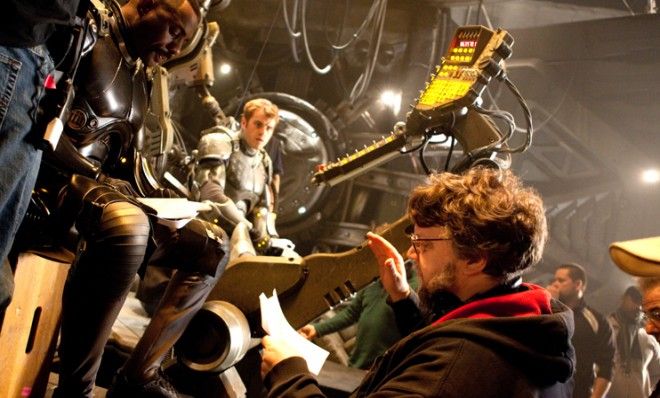Is it too late for Guillermo del Toro's At the Mountains of Madness?
The Pacific Rim director has wanted to adapt H.P. Lovecraft's legendary horror novella for 20 years — but it hasn't happened yet


Pacific Rim director Guillermo del Toro — who once said "the point of being over 40 is to fulfill the desires you've been harboring since you were seven" — has spent much of his career doing exactly that. From the Hellboy series to Pan's Labyrinth, the Mexican auteur has delivered some of the most imaginative and fantastical studio films released over the past decade, and the well-reviewed Pacific Rim seems poised to continue his streak of distinctive and idiosyncratic monster fare.
(Indeed, Pacific Rim has no less a supporter than esteemed pop culture critic Kanye West, who recently dubbed Pacific Rim "one of my favorite movies of all time," and called del Toro "a master" after an early screening.)
Pacific Rim, which pays homage to "kaiju" films like Godzilla, is something of a passion project for del Toro, whom the Los Angeles Times has likened to "a gleeful 10-year-old boy playing an expensive game of Rock 'Em Sock 'Em Robots."
Subscribe to The Week
Escape your echo chamber. Get the facts behind the news, plus analysis from multiple perspectives.

Sign up for The Week's Free Newsletters
From our morning news briefing to a weekly Good News Newsletter, get the best of The Week delivered directly to your inbox.
From our morning news briefing to a weekly Good News Newsletter, get the best of The Week delivered directly to your inbox.
But for every Pacific Rim, there are a half-dozen passion projects that del Toro has been unable to bring to the big screen. He was originally hired by Peter Jackson to direct The Hobbit when it was going to be just two films, before extended delays led del Toro to bow out. He has been attached to everything from a new adaptation of Kurt Vonnegut's Slaughterhouse-Five to the Charles Dickens pastiche Drood. He has discussed helming new, darker adaptations of stories both old (Frankenstein, Beauty & The Beast) and new (Stephen King's Pet Sematary and It).
But there's one long-in-the-works project that stands head and shoulders above all the rest: At the Mountains of Madness, a big budget adaptation of H.P. Lovecraft's legendary 1936 horror novella. At the Mountains of Madness tells the story of Dyer, a geologist and professor who takes graduate student Danforth on an expedition through otherworldly ruins recently discovered in Antarctica. The story is arguably Lovecraft's best — perfectly embodying the florid language, creeping dread, and questions about the boundaries of reality for which he's best known — and it's been adapted into everything from a graphic novel to a PC game to a BBC radio drama.
Lovecraft's work has long presented a problem for Hollywood. His stories remain enormously popular with horror fans, and many are in the public domain, which would seem to make them a perfect choice for adaptations. But it's equally true that the parts of his stories that successfully inspire terror on the page — which tend to involve nightmarish creatures and situations that the human brain literally can't comprehend — are far more difficult to translate to the big screen. Aside from 1985's Re-Animator and 1994's underrated In the Mouth of Madness, Hollywood has either botched Lovecraft's work or ignored it altogether.
But that was all due to change in 2006, when del Toro announced that he'd completed an At the Mountains of Madness script with co-writer Matthew Robbins, a project that had begun with a series of concept sketches in 1993. CGI had finally reached the point at which Lovecraft's nightmarish, inhuman creations could be faithfully replicated, and del Toro was eager to strike out on what he has described as both his "Sisyphean project" and his "dream project."
Sign up for Today's Best Articles in your inbox
A free daily email with the biggest news stories of the day – and the best features from TheWeek.com
From the beginning, studios were universally dubious over the prospect of greenlighting a grim, R-rated $150 million adaptation of Lovecraft's novella, and del Toro reportedly planned to shoot a concept trailer to help convince them. (Hollywood "is very nervous about the cost and it not having a love story or a happy ending, but it's impossible to do either in the Lovecraft universe," del Toro said at the time.) But for all the inherent riskiness of the project, it also attracted two big shots more likely than anyone to turn a dubious financial proposition into a hit: James Cameron, who signed on as a producer in 2010, and Tom Cruise, who was reportedly slated to star.
It was enough to convince Universal to give del Toro enough money to open an art room, where he spent months working with a team of artists on monster designs he hoped would be compelling enough to make the studio move ahead with the project. In a 2011 New Yorker profile, del Toro talked about his then-upcoming meeting with Universal Studio executives. "I've never been this nervous going to a meeting. This invested," he said. "There are certain rules to dating a movie. You try to fall in love when it's a reality, and try not to be completely head over heels on the first date. But I'm hopelessly in love with the creatures." But del Toro was also grounded enough that he refused to compromise on his personal vision: "I don't want to make a movie called At the Mountains of Madness. I want to make this movie. And if I cannot make this movie I'll do something else."
It was this lack of compromise that spelled doom for At the Mountains of Madness, which was originally slated to begin production as early as May 2011. According to reports, Universal clashed with del Toro over his insistence on an R rating, believing that the risky film's only chance of success would be a PG-13 rating. Though del Toro reportedly attempted to move the project to 20th Century Fox, he never got as close as he did with Universal; in 2011, he wrote that the release of Prometheus, which bore significant similarities to Lovecraft's At the Mountains of Madness, would "probably mark a long pause — if not the demise" of his own film. (It's worth noting that Prometheus — a similarly risky R-rated sci-fi/horror blockbuster produced for $130 million — was a hit, grossing over $400 million worldwide despite its tricky subject matter and so-so reviews.)
Guillermo del Toro's dance card is pretty full right now. In addition to the aforementioned hypothetical projects he's tossed around in various interviews and appearances, his IMDB profile includes two films and two TV shows currently in pre-production alongside the long-rumored Hellboy 3 — and if Pacific Rim is a hit, Pacific Rim 2 will likely be added to the list as well. But it's hard to imagine that del Toro doesn't still have soft spot for At the Mountains of Madness, which represents the rare project where a filmmaker seems not just capable, but tailor-made for the material. In an interview with Indiewire in January, del Toro vowed that he would try "one more time" to get At the Mountains of Madness made, with Tom Cruise still attached to star. "Once more into the dark abyss."
As Guillermo del Toro once noted, H.P. Lovecraft stories don't have happy endings, so the inauspicious end of his At the Mountains of Madness adaptation — more than 20 years after it was first conceived — may seem bleakly fitting. But that doesn't mean we can't keep hoping that a happy ending is on the horizon.
Scott Meslow is the entertainment editor for TheWeek.com. He has written about film and television at publications including The Atlantic, POLITICO Magazine, and Vulture.


